Over the past several weeks I have dedicated several hours to getting the SB-200 to a point where I could apply voltage to it. I purchased the Harbach HV board from Harbach Electronics to replace the factory HV board and the original paper caps. With NO IDEA of the last time this amp was even turned on, nor the condition it was in when it was last operated, I made the decision to replace the board and all the components on it, as well as several other smaller mods to the amplifier.
The board install was pretty straight forward, with great directions supplied in the manual. They were step by step directions, similar to those in the original Heathkit SB-200 manual. Knowing that this kit was going to have 2400V flowing through it, I took my time to check each and every solder joint to make sure that they were all good and clean. I figured the time spent during the assembly would pay off with years (if not decades) of operation of the amp later. Looking at the wiring of the amp, I can tell that the last owner had taken similar care, which was one of the reasons I felt so comfortable working on the amplifier as well as feeling confident with what was already done during the initial amplifier build.
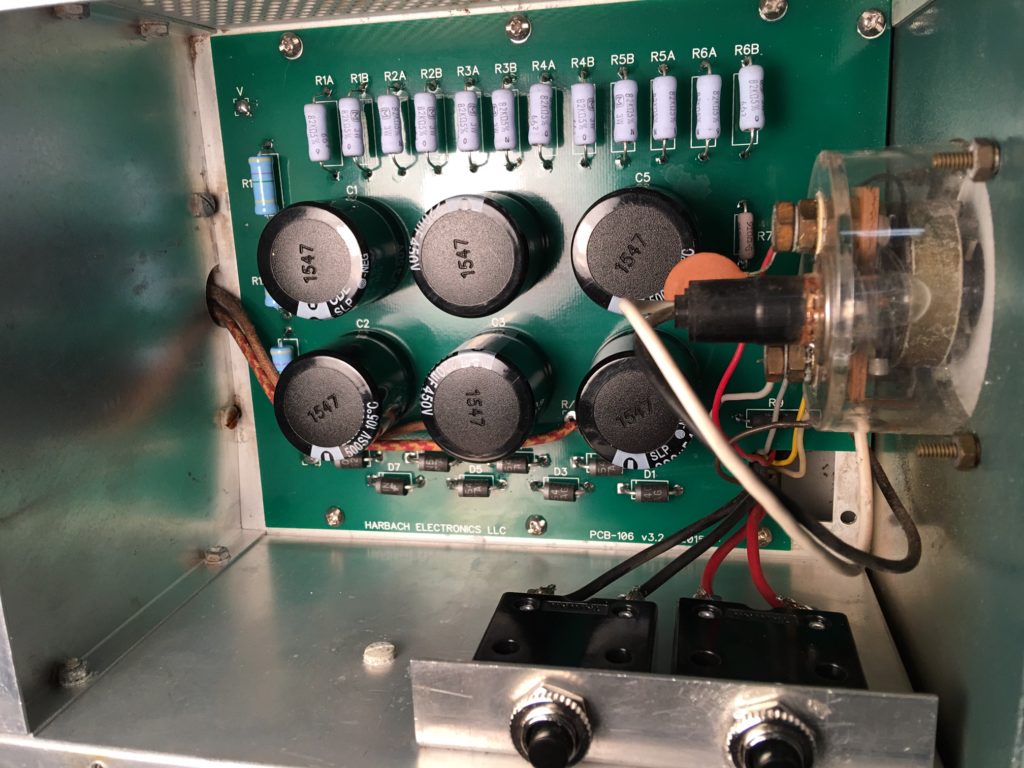
New HV board kit assembled and installed in the SB-200.
At the same time that I installed the HV board, I also replaced the circuit breakers based upon the original amplifier design. Those can be seen in the lower right of the above image. One of the original breakers was seized up, so I knew early on I was going to replace these as well. (However, the reason for the condition of the breaker had escaped me.) They were a simple replacement.
Beyond the HV board, I replaced the two filter electrolytic capacitors, both of them were the old paper design. Out they came and replaced with the two as recommended from Harbach, a 2.2 uF and a 22 uF capacitor.
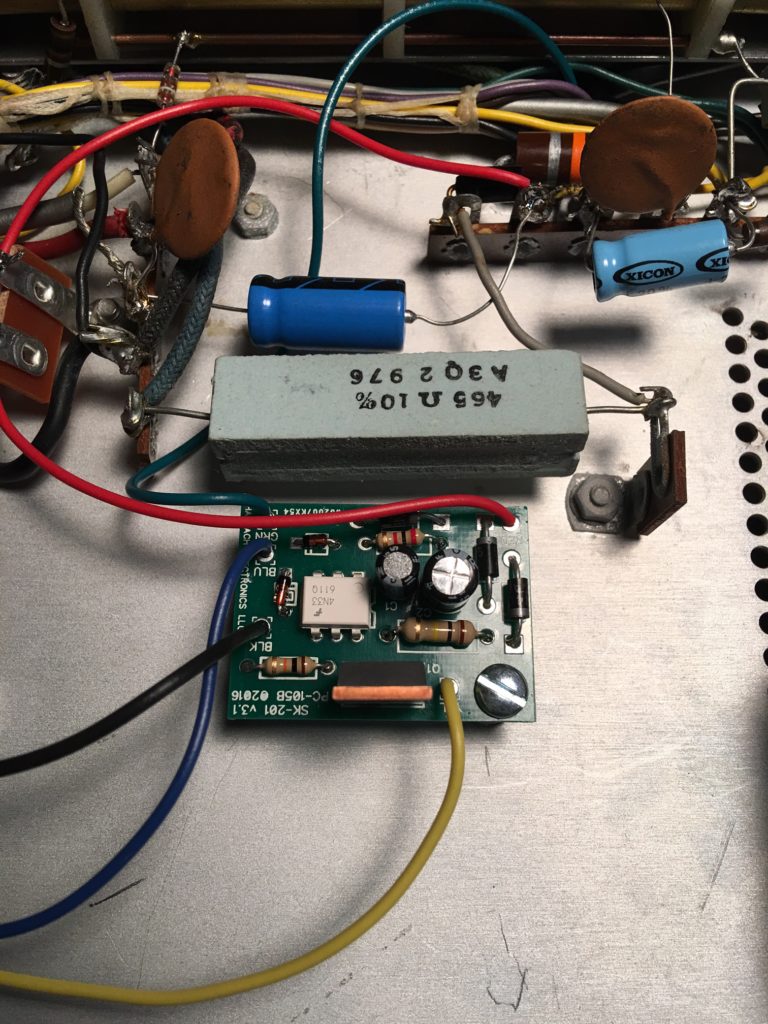
Soft-Start kit and the capacitor replacements.
At the same time I was installing the Soft-Key kit, I assembled the Soft-Start kit that came with the HV board. The Soft-Start was an upgrade board that takes the stress off the amp by mitigating the inrush of current when turning the amp on, by feeding the current through a set of relays before it hits the rest of the circuit. Some have stated that when you upgrade the original (or new) HV board to larger capacitors to allow for more stable HV when operating the amp under load (aka, less voltage drop on key down) you run the risk of tripping the circuit breakers in your house when you turn the amp on, due to the current draw of the amplifier to charge the capacitors. The Soft-Start kit looks to eliminate this issue. However, there are mixed reviews on whether or not this mod is needed. Some say as long as you stick with the caps that come with the new HV board, you are fine and don’t need it. Others argue that any protections that you can add to a 50 year old amplifier design is a good thing. Since I had the kit, I went ahead and assembled it and spent about 2 hours looking for a suitable place to install it on the underside of the chassis. Every web page and google search showed one of two locations to mount the Soft-Start kit, but in my case both were blocked with wiring. The primary location was blocked with the blue high voltage wire that was coming from the HV board. In 99% of the images of other builds, there was enough slack in their wiring to move it out of the way to then install the Soft-Start board. In my case, I didn’t have any slack to move the wire around. This lack of slack and contemplation over the placement of this kit for so long must have been karma, as I while I was not able to find a suitable location, I was rewarded with finding a 5mm exposed section of the HV wire, where an errant soldering iron melted away the wiring insulation! I could tell that this was an “old” injury based upon the location and condition of the wire. (And maybe the reason for that fried circuit breaker?) However, if I had not spent all this time looking for a place to mount the Soft-Start board, I would have never seen this, and missed a real potential point of failure. Some heat shrink tubing, a hair dryer and 10 minutes of time later, the fix was good to go. (below)
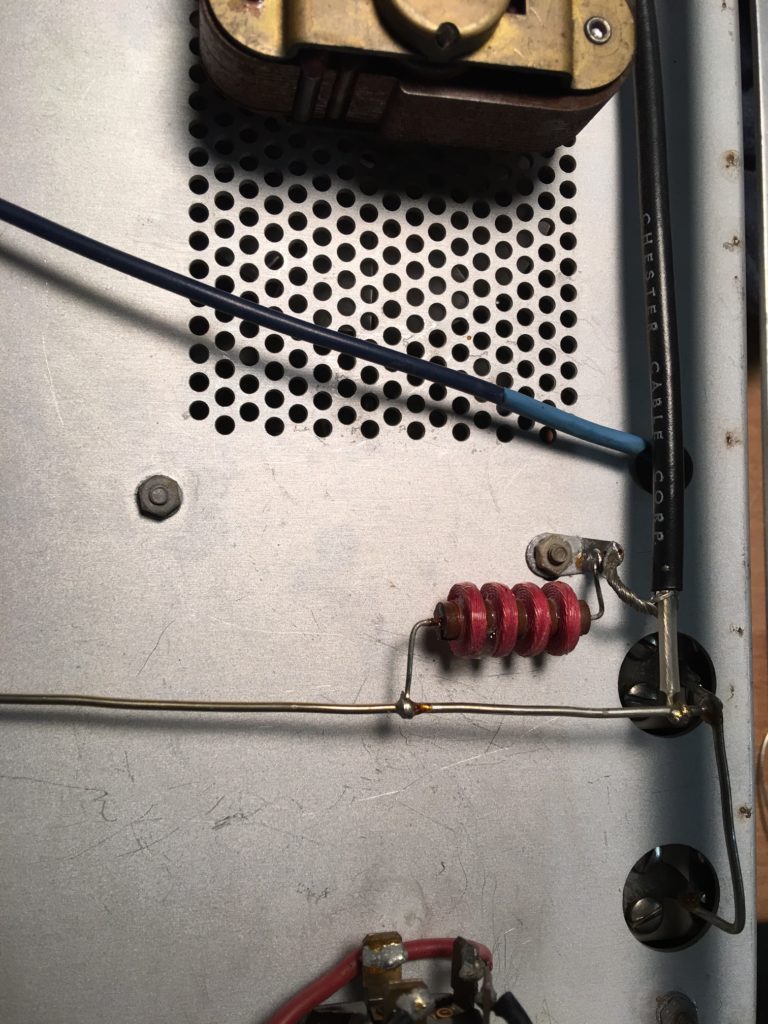
Check everything when looking to restore unknown condition ‘barn finds’!
I didn’t replace the relay or the fan, both common replacements in this amplifier. Both looked good. The relay was not pitted and not bad when compared to others I had seen in other restoration projects. The fan spun easy (even with compressed air moving it) and the fan assembly also looked good from the underside of the chassis. Seeing that it was in good shape, I figured I didn’t need to replace it. Combined with the notion that I was already planning on mounting a smaller muffin fan on top of the case to draw/suck the hot air out of the amp. I imagine I will eventually have the 120V muffin fan wired right into the amp, once I get the location and wiring laid out so I can still open the case with the fan mounted, etc. Or, maybe I mount it under the amp pushing air into the chassis under the tubes… again.. I have to noodle more about this one. Push air in, or draw air out. hummm…
Time to make the donuts!
Or in my case, start applying voltage to the amplifier for testing!
When I started in on this project I made a promise to myself that I would NOT work on the amp if I was tired, or not interested /focused on what I was doing at the moment. I have this internal drive that will push me to finish projects or physical activities when the desire to complete them has long passed. More of a “put your head down and march on” mentality. Well….. it is one thing to have that attitude when you are looking at doing 90 burpees, or grinding out another 12 miles on a hike or run. However, when working with something that can, as the manual states.. “WORKING WITH HIGH VOLTAGE CAN BE LETHAL! MISTAKES CAN KILL YOU..” I tend to lean towards self preservation, and fight the desire to push on. Rather, put the project aside and work on it another day. This was me last night. I had run my final inspection, my final cleaning, did the resistance checks as required in the Heathkit manual and everything looked good. I wanted to test it, but I was quite tired. Tomorrow would be the day to see if the time, energy and $ that I had put into this project was going to result into something positive. This barn find was untested. Hell, I didn’t even know if the transformer was going to work. I could flip the switch and end up with nothing. However, tomorrow would have to be the day to find out.
Tomorrow is Today
As soon as I got home, I changed, and went right to the amplifier.
I took off the metal RF screen that protects ME from the innards of the amplifier so I could get a better look at the tubes as well as the HV board. I wanted a clear view of the various parts of the amp as I would be applying voltage to the amp and the tubes via a variac, bringing up the voltage a few volts at time over several minutes. All the while keeping my hands OUT of the area. However, how would I know if the tubes were any good?
What should I be doing with them since they have been sitting so long?
Again, I have NO idea when the last time these tubes saw voltage. I pulled the tubes out of the chassis, and sprayed the anode clips with contact cleaner, making sure I protected other areas of the amplifier when I did this.
Searching the internet I found this procedure as far as testing out the tubes and the amp.
Title: RE: SB 200 Capacitors and 572B Tube Questions Post by: W1QJ on December 20, 2014, 11:29:52 AM It takes 5 minutes to determine if the tubes need work or if they are trash. But first you want to test the amp without tubes. All testing is done using a Variac while bringing the line voltage up slowly. First without tubes. Use Variac to bring up line voltage slowly, watch the plate meter for the increase in high voltage as you go up. The HV should show on the meter immediately and there should be no groaning of the transformer. If you don't see HV coming up and you hear groaning sounds, your next step is to rebuild the power supply. If you can check out the PS like this and find it's OK, then install the tubes. Leave the top screen off so you can see the tubes, put meter in grid position. Again, bring up line voltage slowly, watch for ANY plate or grid currents either positive of negative. If you see any sign of these currents, you have bad tube(s). Time for new ones. If no indications, then continue raising the line voltage. Watch the tubes for any gas as well as still watching meters. Gas will show as a bluish hue inside the tube. If you see Blue the tubes are gassy and if you have very little plate voltage they are probably too far gone. That's it.
https://www.eham.net/ehamforum/smf/index.php?action=printpage;topic=100275.0
Thanks Lou!
This would be process that I would follow tonight, over the course of a few hours, bringing up the voltage slowly (and pausing every 10v or so for 10 – 15 min), all the while, checking on what I saw, smelled and heard.
I set the varic to Zero volts and turned it on, then I reached over and I would lying if I said I didn’t have some hesitation- and flipped the large black power switch on the SB-200.
I slowly started turning the variac stopping every 5 volts for about 10 minutes.
- Around 30V the pilot light for the meter started to crackle and glow
- Around 60V, the tubes started to glow (equally)
- Around 80V, the fan kicked on
- Around 90-100V, I was seeing 1700V on the HV meter
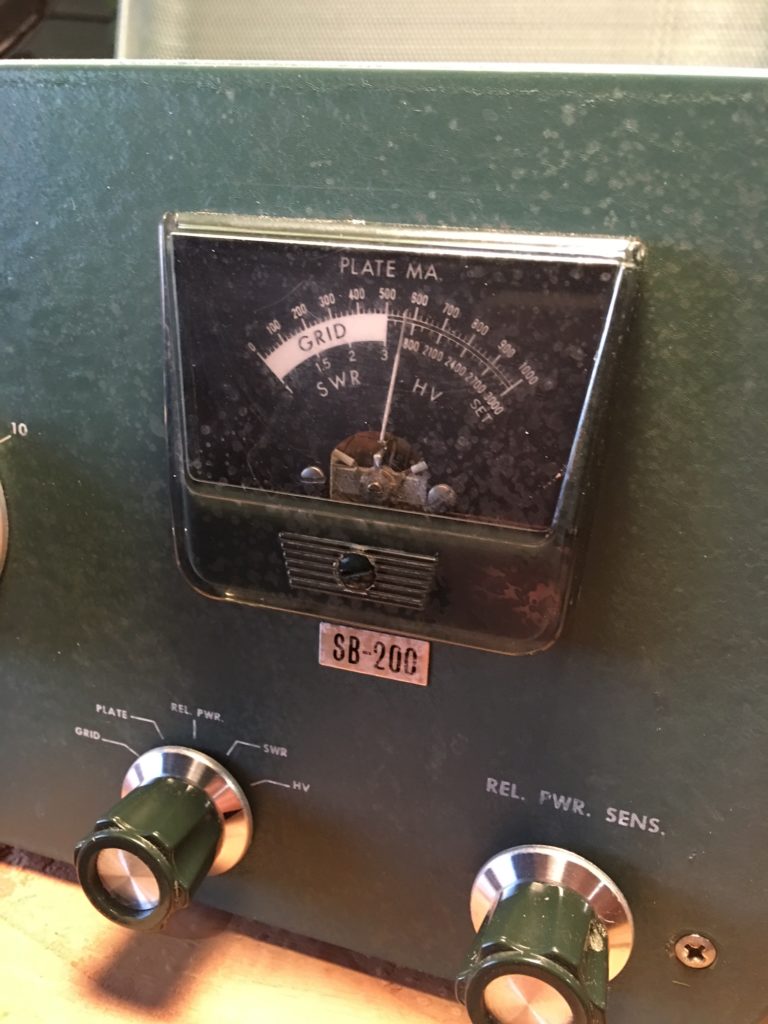
1700V on the plate! Testing continues. (Yes, I know the meter glass as well as the amp metal face is spotted, anyone have a good way to clean that?)
At 110V I was seeing about 2100V on the meter. The fan was spinning at the fastest rate at this point, and was very quiet. The spinning was balanced as I didn’t hear any squeaking or vibrations from the fan either. I guess I don’t need to replace this one. 🙂
At 120V, I ended up seeing 2300V on the HV meter. (125V got me to 2400V). I let it sit at 120V for another 40 minutes before I shut the amp down for the evening. I never released the magic smoke, nothing blew up or burnt up.
Success!
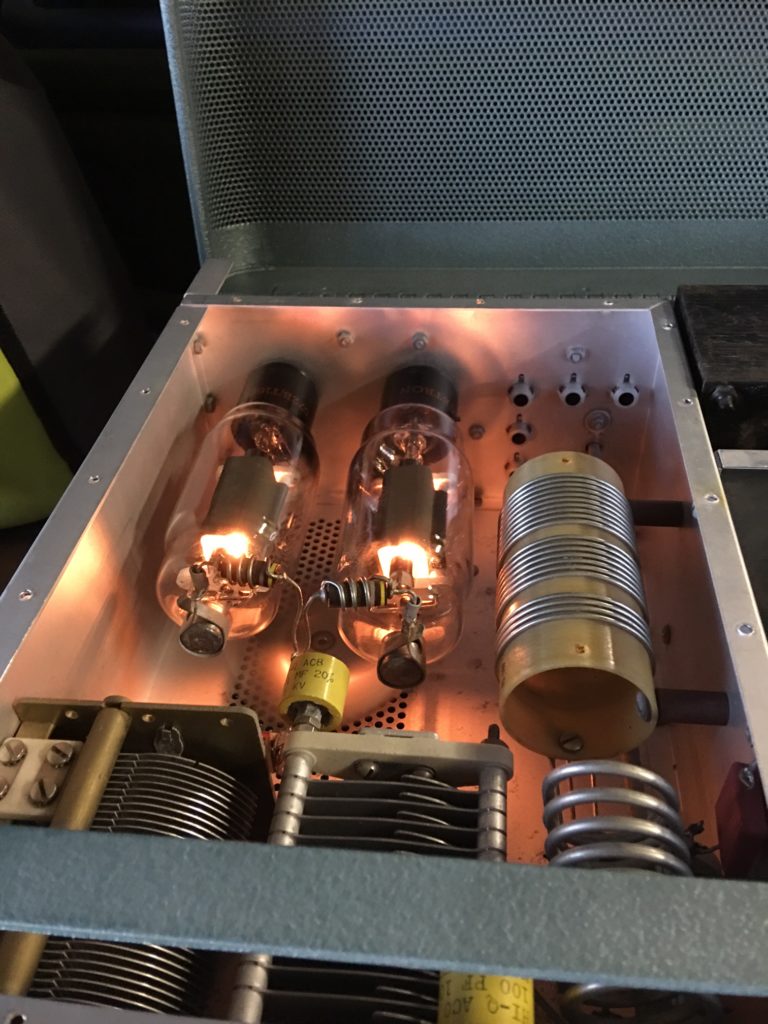
Tubes are glowing – High Voltage is flowing.. and I need to keep my fingers out of there!
Next steps (Part III)
The next steps will be to run the variac test again (well, several times). Then I need to do the following:
- Test the keying by keying the jack to the chassis
- Measure the voltage of keying jack (test that the Soft-Key mod is wired correctly)
- Get a hold of a 1000W dummy load (Hey.. who in the club has one?)
- Key the amp and test for voltages (screen, grid, plate)
- Key the amp and apply RF
- Measure RF output on each band
- Take more pics
- Get it over to the operating position
- WORK stations!
- Enjoy the process
So far so good – excited to start on Part III.
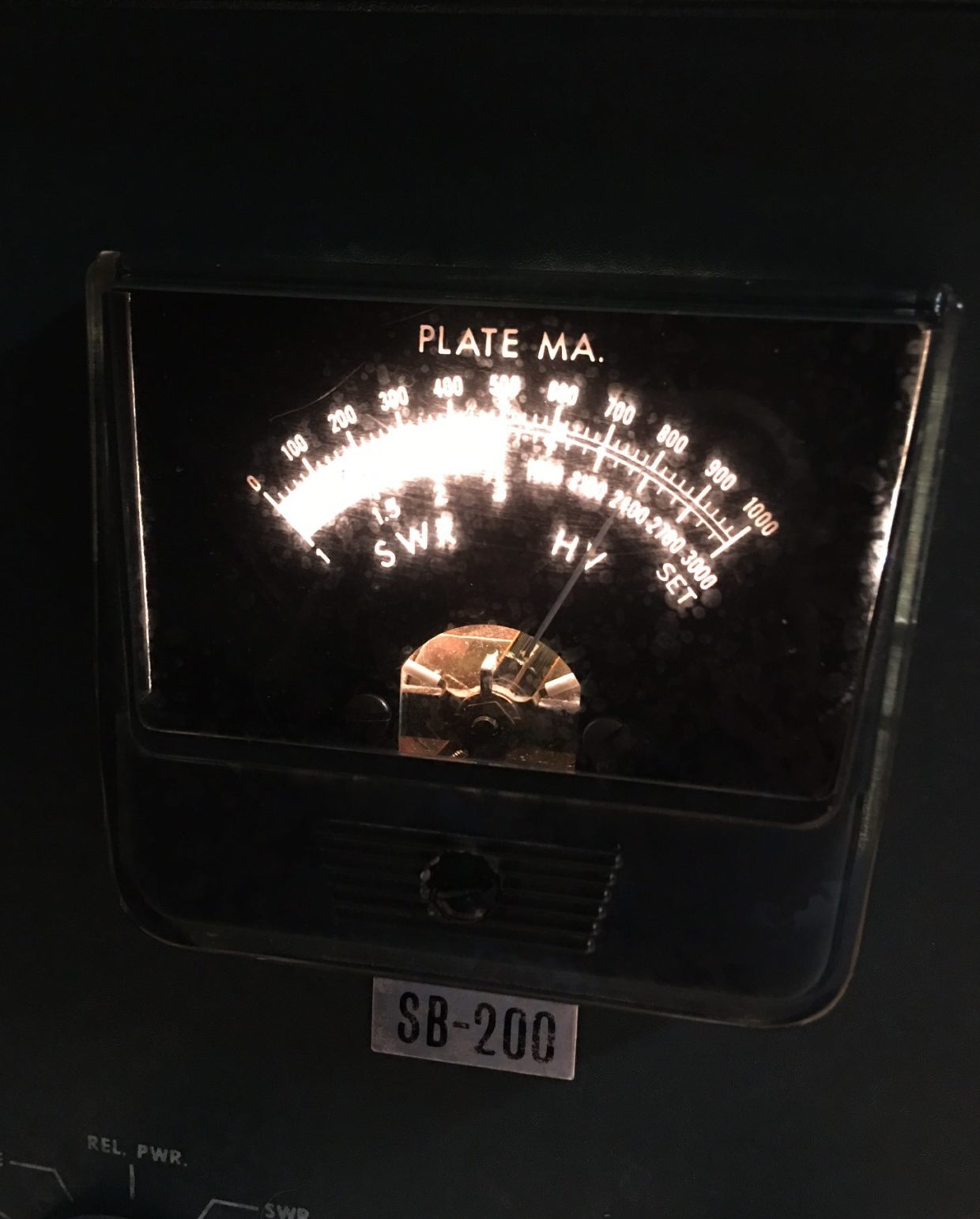
J. M. mallafré September 4, 2017
The best way for clean the plastic meter is with toothpaste, cotton rag and be patient !!
73EA3BDD
n1rwy September 8, 2017 — Post Author
Thanks for the comments, I will have to try that. Being patient isn’t my strong suit! hi hi!
Dave, N6KL August 1, 2017
Thanks for the great article. I have an SB-200 with the SoftKey board and it has been working wonderfully. As for the meter plastic, I would carefully try using the Meguiar’s Plastic Polish #10 on a small spot and see if it clears that up. Or you can use the slightly stronger Plastic Cleaner #17 and then follow up with the Plastic Polish #10. I’ve used these on the plastics for motorcycle helmet shields and windshields for many years with good results to remove that type of blemish without scratching.
n1rwy August 15, 2017 — Post Author
Thanks for the tip Dave!
Kelly March 17, 2017
The SB-200 is a really good amp. I had one along with an SB220 and unwisely sold them some time ago. They both at one time had belonged to my Dad.
I have a 30L-1 Collins that is similar to the SB-200. I put the Harbach power supply kit in that amp and it works great. You are doing a good job getting this old amp back together.
n1rwy March 26, 2017 — Post Author
Thanks Kelly! It has been a lot of fun rebuilding the amp and working my way through the vintage manual and online forums.
Joe December 29, 2016
Nice article, great pics – glow baby glow.